Email Engagement Strategies: The Smart Marketer’s Guide
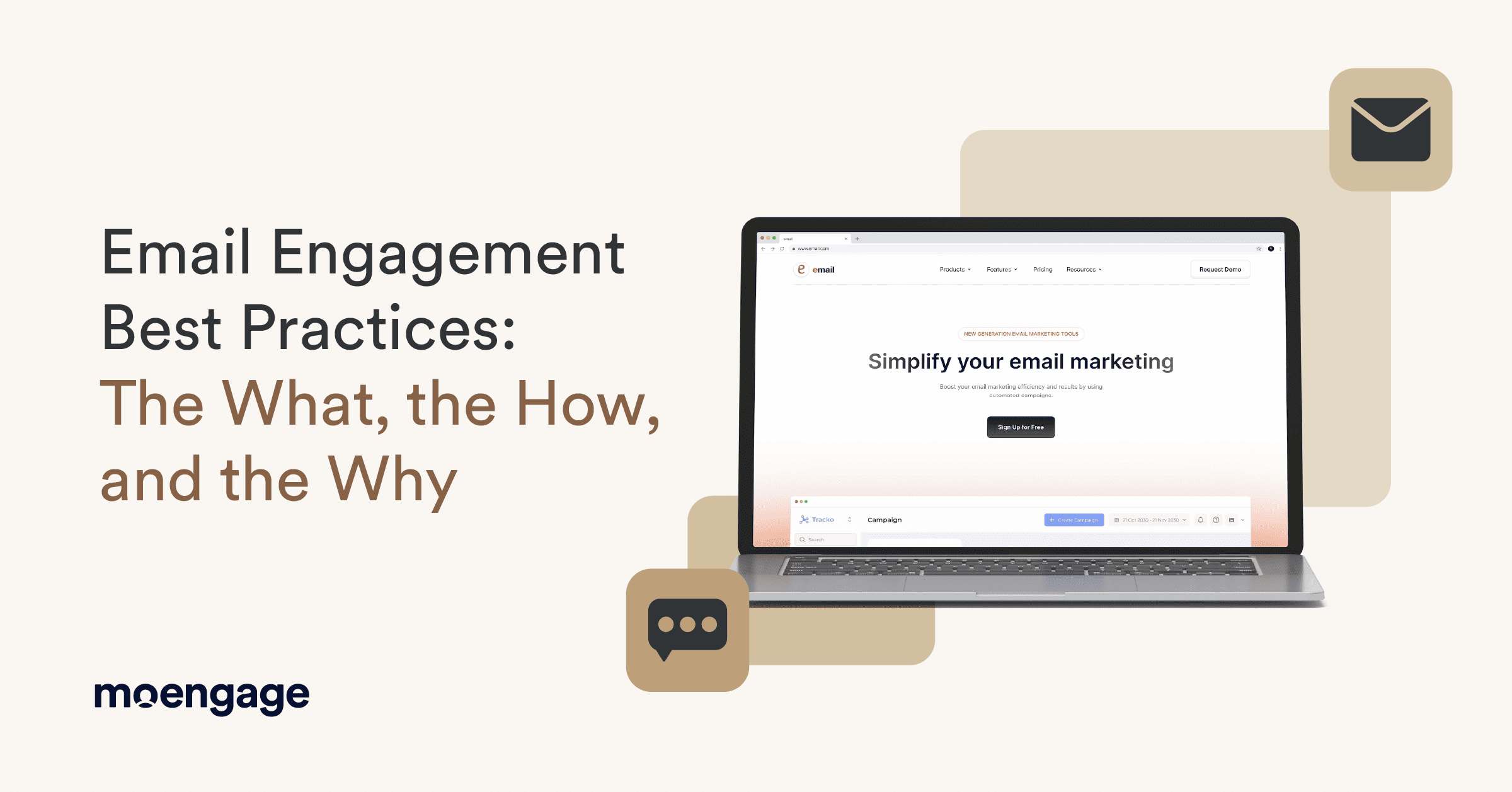
Reading Time: 9 minutes
You spent hours crafting the perfect email with the right images and expertly worded copy, however, once you send it, the results are not what you hoped for. Low email engagement, disappointing open rates, and even a few unsubscribes!
A big piece of the email marketing puzzle is understanding how to engage your audience so they actually want to open your emails, read them, and take the desired action.
But the problem is, every brand out there uses email as a core marketing strategy, making it more difficult to cut through the noise and stand out. Let’s face it: How many unopened emails are sitting in your inbox right now?
That’s precisely what we want to address in this article. Keep reading to learn how to craft compelling subject lines, time your emails, and track the right metrics.
What is Email Engagement?
Email engagement refers to how recipients interact with your emails, measured through actions like opens, clicks, replies, and forwards. It’s an indicator of how effectively your message captures attention and drives response—more than just being seen, it sparks interaction, much like a two-way conversation.
A high email engagement rate means consumers find your email content valuable. In contrast, a low engagement rate indicates that your audience is either ignoring your messages or marking them as spam. The key is to design emails following email marketing best practices to keep your audience interested.
Engagement vs email re-engagement: What’s the difference?
Although they sound quite similar, engagement and email re-engagement are very different.
Email engagement is all about how your audience interacts with your emails—whether they open them, click a link, or reply. Marketers must focus on aspects like eye-catching subject lines, compelling email copy, personalization, and delivering content that resonates with their subscribers’ interests to maintain strong email engagement.
On the other hand, email re-engagement refers to the process of winning back subscribers who have not interacted with or opened your emails in a while. This happens when your audience loses interest in the emails you send.
A critical part of email re-engagement is reminding your readers of the value you provide. This may include special incentives, personalized reminders, or exclusive content that can re-spark their interest. If a subscriber continues to remain inactive, remove them from your email list to avoid compromising your reputation and improve email deliverability.
5 Email Engagement Metrics: How to Measure + Rates to Aim For
Email engagement metrics are essentially the KPIs you track to measure how well your audience is resonating with your emails. It indicates the efficacy of your email campaigns, helping you identify what kinds of emails are working and what’s not.
What’s a good email engagement rate?
According to MoEngage’s latest Email Benchmarks Report based on the findings from 17 billion emails, a decent email open rate is 20%, while a good email open rate is above 25% or 35%. On the other hand, a good CTR can fall between 2% and 5%.
Although these numbers vary by industry and campaign type, marketers can use them as a baseline to improve their email engagement.
How to measure email engagement: Top 5 KPIs to track

Here are the top five KPIs you need to track to measure your email engagement and the performance of your email campaigns.
1. Open rate
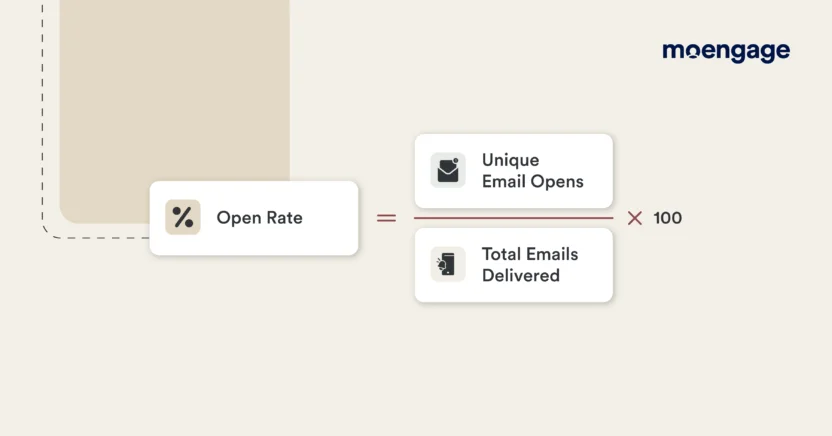
This is the most fundamental email engagement metric you can track. For instance, if you sent 10,000 emails, of which 2,500 were opened, your email open rate would be 25%.
Email open rates give you insights into how compelling your subject lines are. The more engaging and interesting your subject lines, the higher the chances of your email being opened.
A poorly timed email may also have low open rates. For example, let’s say you send a flash sale email at 2 AM when your audience is most likely asleep. It is going to be buried under numerous other emails, reducing the chances of its being opened.
2. Click-Through Rate (CTR)
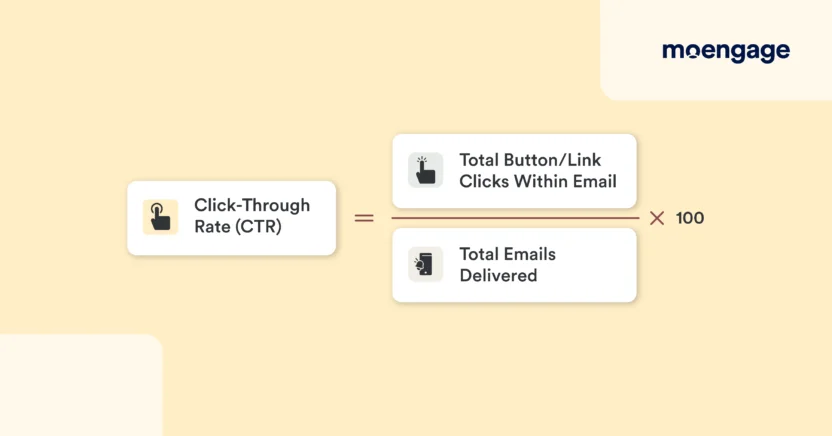
Email CTR tells you the rate at which recipients click on any link within your emails.
Let’s say you sent 10,000 emails and received around 500 total clicks. In this case, your email CTR would be 5%.
A high email CTR indicates that your audience found the email you sent quite interesting, and that the content is actually driving them to take action. A high email open rate with low CTR indicates that although your audience found the subject line intriguing, the actual body of the email did not pique their interest.
Low CTRs could be because of weak CTAs, irrelevant or uninteresting content, or poor design. You can try to improve your CTRs by experimenting with different email layouts, CTA placements, and content personalization.
3. Click-to-Open Rate (CTOR)
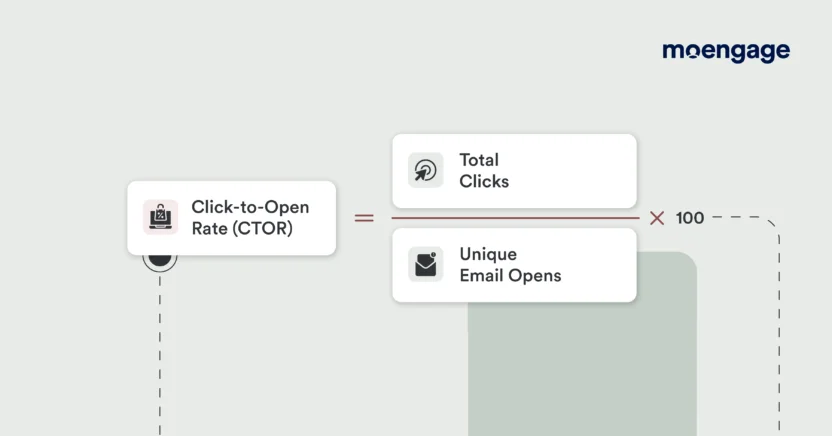
If you want to measure the effectiveness of your email content in driving email engagement, you need to analyze the email CTOR. It is similar to CTR in that it measures the total number of clicks your email gets. But instead of considering the total number of emails delivered, CTOR is based on the number of recipients who actually opened the email.
So if 2,000 recipients opened your emails, of which 400 clicked on a link within the email body, your email CTOR would be 20%. This means that 20% of consumers found your email content engaging enough to click a CTA.
A high CTOR is suggestive of well-structured content and CTAs in your email.
4. Conversion rate
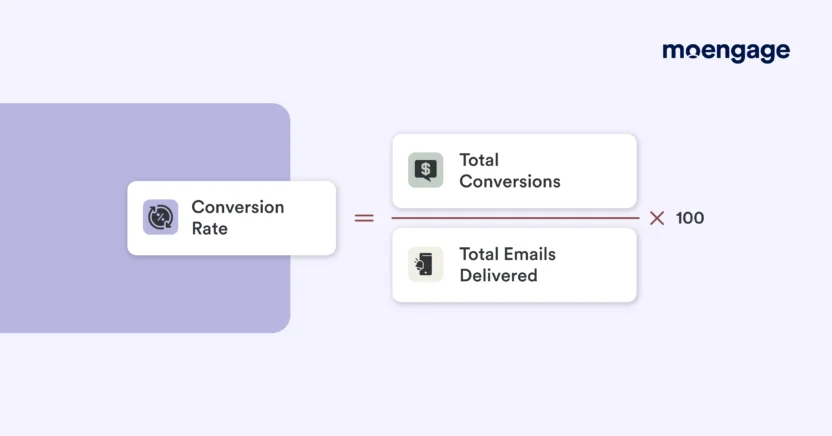
Suppose you want your recipients to take a particular action after reading the email you sent them. It could be making a purchase, signing up for a webinar, downloading an ebook, or anything else you want them to do.
Conversion rate tells you how many of your recipients took the desired action after reading your email. It is a critical KPI, since it ties your email engagement to specific business results.
A low conversion rate may indicate that your email copy is not compelling enough. It could also signify a problem with the landing page, the link, or the offer you’ve included in the email.
5. Unsubscribe rate
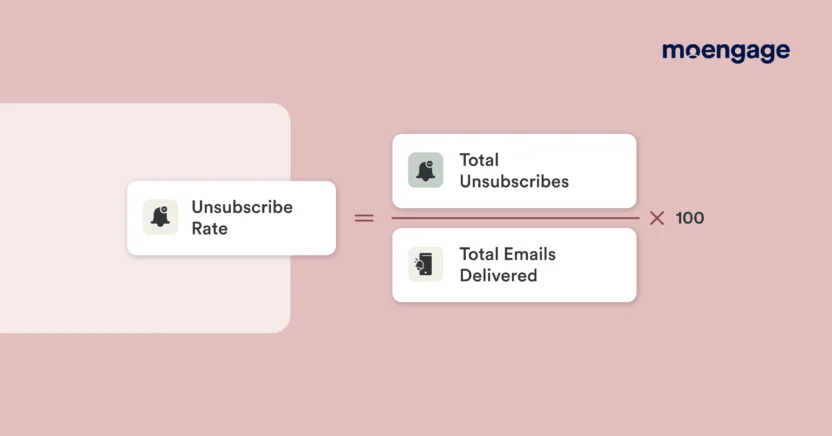
The unsubscribe rate is an important indicator of audience dissatisfaction. It basically tells you how many contacts in your list opted out after receiving a particular email.
Some unsubscribes are part and parcel of email campaigns, and there’s nothing you can do about it. But if you notice a sudden spike in your unsubscribe rate, you might need to modify your email strategy as a whole. Pay attention to the frequency of your messages, or improve audience segmentation.
Improving Email Engagement Rates: A Step-By-Step Guide
There are approximately 4.6 billion email users worldwide in 2025. That number is projected to grow to over 4.8 billion by 2027. With such a vast audience base, email is a non-negotiable part of your marketing strategy. It is imperative to craft compelling, relevant, and engaging emails that stand out in crowded inboxes.
Here’s a brief guide to improving your email engagement. This will maximize your chances of connecting with your audience and inspiring them to take action.
1. Personalize your emails
No matter how often we say it, we can’t overstate the importance of sending personalized emails to your audience. Tailoring your email content to audience preferences, behavior, demographics, and browsing behavior will likely make your emails stand out in a sea of impersonal, robotic-sounding emails.
Instead of sending them generic mass emails, it tells the audience you took the time and effort to find out what they like. This increases open rates and CTRs, since consumers are more likely to engage with emails when they find them relevant and well-crafted.
How to do it
- Send emails based on your audience’s actions. For example, you can set up automated email marketing campaigns when your subscribers are newly onboarded to your platform, during their anniversaries, or when they abandon their cart.
- Use segmentation based on specific criteria and the data in your emails to make them feel more personal.
- Personalize emails using a real person’s name in the ‘From’ field, so they sound less robotic.
2. Use compelling subject lines
Let’s face it, how many emails do you actually open in a day? Research from Hubspot finds that 64% of consumers decide whether or not to open an email based on the subject line. This is not surprising, since the subject line is the first thing consumers see in their inbox, and a strong one can improve your open rates and ensure your message gets read.
In fact, a weak or even misleading subject line can do more harm than good. In addition to impacting your email engagement, it can even lead to spam complaints. This is why using meaningful and relevant subject lines in your email campaigns is crucial.
How to do it
- Try to be direct and descriptive, rather than following the trend. Highlight the value of your promotions or deals.
- Use shorter subject lines, ideally no more than 9 words or 60 characters. These read better on mobile devices.
- Include emojis strategically within your subject lines to reinforce your message.
Here’s an example of a subject line crafted using the above tips: 🔥 Limited-Time Deal: 30% Off Just for You!
3. Write engaging and valuable email content
The bottom line when it comes to driving action using emails is to use content that consumers actually care about. Your emails need to be well-written and captivating for the reader. Otherwise, they’re just meaningless marketing jumbles, less likely to inspire any action from your recipients.
Consumers tend to read things they’re excited about or when they bring specific benefits to their lives. So when you write emails, think about the message from the reader’s perspective and create content that directly speaks to them.
How to do it
- Clearly define your audience, their pain points, and their needs. Create content centered around one or two key goals, rather than addressing too many things at once.
- Focus on what your offerings mean for the reader. If you’re talking about a product or service, avoid using technical language and focus ohow the reader can find value.
- Use a normal, conversational tone as much as possible. The goal is to speak to your audience, not confuse them.
Here’s an interesting example of how Starbucks sets its email apart from dozens of others in a customer’s inbox.
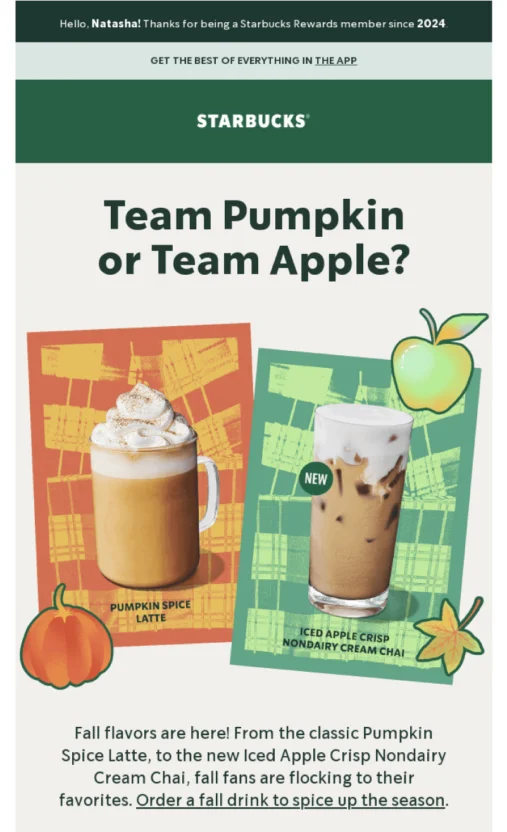
4. Optimize for mobile users
Nearly 36% of all email opens are done on mobile devices. This makes a strong case for ensuring your emails are optimized for mobile devices. If your email isn’t mobile-friendly, chances are, they’ll end up being deleted or ignored.
How to do it
- Use responsive email templates that can adapt to any screen size
- Make sure to test all your emails on different devices before you send them to your audience
- Place your CTAs so that they’re properly visible, and adjust button sizes so they fit perfectly within your email layout
5. Time your emails
Like with any marketing campaign, emails need to be sent when you’re sure your audience is likely to engage with and open them. The exact timing will depend on the content of your emails, the industry you’re in, and the kind of audience you cater to.
For instance, an Ecommerce retailer may send emails about flash sales and promotions when shopping activity is at its peak. But a career counseling company might see better engagement when sending emails on weekday mornings.
How to do it
- Analyze audience data to see when they’re most active online
- Build a regular sending schedule and be consistent with your timing
- Experiment with different send times to find out what works best for your audience
Implementing these best practices can definitely boost your email engagement. However, you can’t take a one-size-fits-all approach when it comes to email performance, especially if you’re dealing with recipients across multiple geographies. What works in one region might not work in another.
More Email Engagement Best Practices [Videos]
Want to dive deeper? Check out our insights on boosting email engagement in the US.
The New Rules of Email Deliverability
Watch this video clip to get insights from Josie Garcia, Senior Email Deliverability Consultant at Inbox Monster, on:
- Current trends in email deliverability
- How to navigate the ISP landscape, and more
The Power of Behavior-Based Emails
In this short video, Aditya Vempaty, VP of Marketing at MoEngage, shares his insights on:
- How personalized emails boost engagement compared to standard emails
- The performance of emails sent to customers at the right time
- Conversions of behavior-based emails related to standard emails
Common Email Mistakes to Avoid in 2025
From this clip, you’ll learn expert-backed best practices for avoiding common email marketing mistakes with insights from Monica Mahale, Director of Product Marketing Growth Marketing at Movable Ink. You’ll get to know:
- Batch-and-blast emails aren’t going anywhere soon!
- The changing definition of broadcast emails
- The role of AI in personalizing emails
Boost Email Engagement and Conversions with MoEngage
The most important aspect of an email marketing campaign is figuring out how you can design it for maximum impact. This could include crafting attention-grabbing subject lines, adding a layer of personalization, and figuring out what generally resonates well with your specific audience.
Your emails need to be well-thought-out, highly personalized, and sent at the right time so that they actually land in your customers’ inboxes and interest them.
A great way to do this is to use a platform that can power up your email marketing strategy by helping you build personalized emails at scale. MoEngage’s all-in-one email marketing platform offers a robust suite of features designed to help marketers create out-of-the-box emails that align with their customer’s preferences, journey stages, and behavior.
Want to see how MoEngage elevates your email engagement rates? Sign up for a demo.









